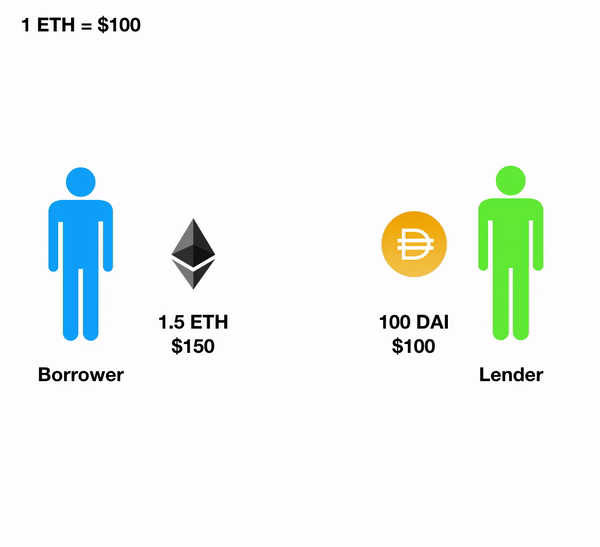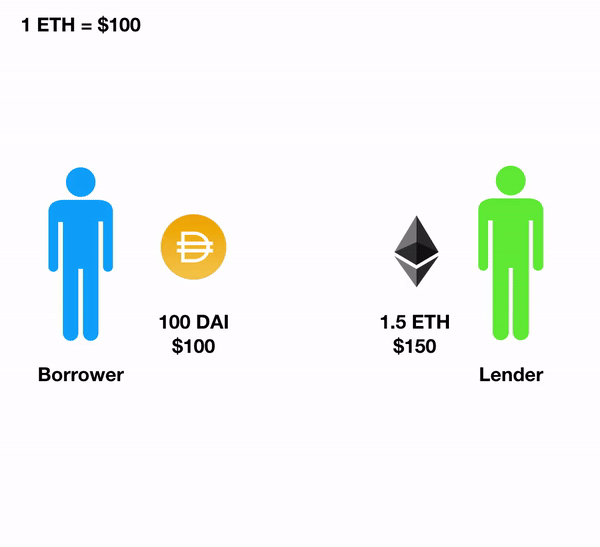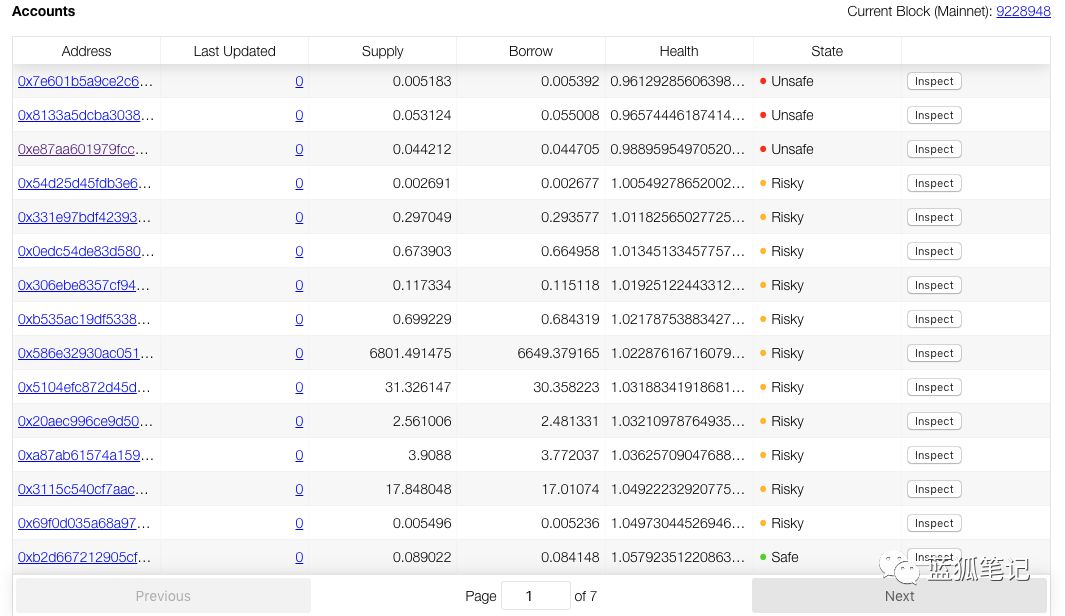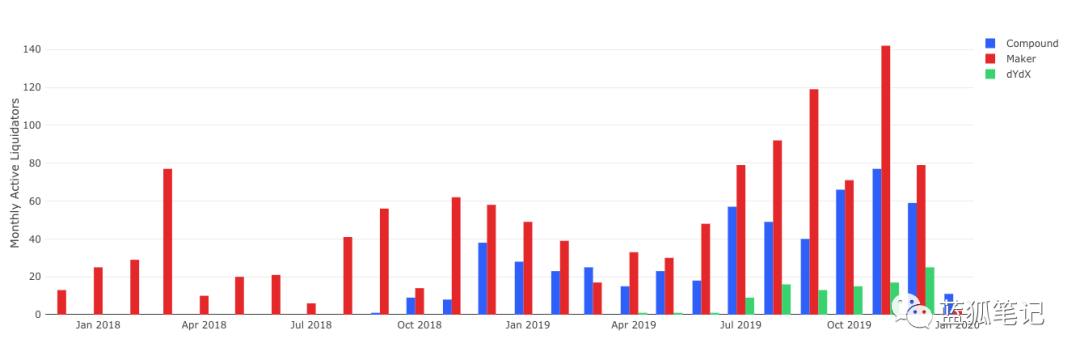Liquidators: How to make a huge profit on DeFi
Foreword: In the field of DeFi, people pay more attention to borrowed assets, interest rates, mortgage rates, etc., and one of the important roles to keep the lending agreement running normally is the liquidator. They work behind the scenes and are rarely known, but they maintain the market Solvency. Of course, their earnings are also very considerable. So far, the DeFi field has provided liquidators with close to $ 500 million in profits. With the increase of entrants and the introduction of the auction mechanism, this profit margin is also shrinking, but as the DeFi market grows, the overall space still has the opportunity to continue to rise. The author TomSchmidt, translated by "SIEN" from the "Blue Fox Notes" community.
In the field of DeFi, the liquidator is an under-researched role. Like miners and validators, they work behind the scenes to maintain the normal operation of the entire system and get rich returns for this. However, unlike miners and validators, the liquidator does not actually require any upfront capital investment, it creates an ecosystem of professionals, operates completely anonymously anywhere in the world, maintains market solvency, and thus Get paid.
What is liquidation?
Over the past two years, Ethereum has issued a number of decentralized lending agreements, including MakerDAO, Compound, and dYdX, among others, which allows anyone to borrow or lend crypto assets without trust. Although these agreements differ in their approach to entering the market, the assets they provide, and the terms of their loans, the basic lending structures are the same. The borrower deposits the collateral into a smart contract. In return, the borrower can borrow other assets provided by the lender, but the amount is less than the collateral. This secured loan is one of the most primitive financial instruments, going back to the medieval Venetian banking industry, in stark contrast to unsecured credit-based loans that consumers are more familiar with.
When the value of the collateral exceeds the value of the loan, the mortgage-guaranteed loan works well so that the borrower can obtain liquid funds without having to sell its usually less liquid assets. However, when the value of collateral falls, rational borrowers have incentives to evade repayments, which could put lenders in trouble.
- Cryptocurrency money laundering analysis: how criminals will transfer billions of dollars in 2019
- Crypto asset service provider Keystore secures $ 10 million in funding, led by Jianyuan Fund, distributed capital follow-up
- 8 asked videos | Conflux Long Fan: Only by reducing the interaction cost with the public chain will there be more applications
After all, who wants to repay 100 DAI to redeem $ 99 worth of ETH? For more traditional forms of secured loans, such as car ownership loans or mortgage loans, this is not a problem, as these assets are generally less volatile than cryptocurrencies. However, when we use ETH as collateral for loans, the value can plummet in seconds.
 Mortgage loans may be risky if not liquidated
Mortgage loans may be risky if not liquidated
In order to mitigate risks, lending agreements usually require at least 115% of collateral (Blue Fox Note: generally more than 150%, not much about 115%), which leaves sufficient buffer space before the collateral falls below the loan value. If the value of the collateral falls below this level, the borrower can simply deposit more collateral or sell the collateral to repay the lender and maintain the system's solvency. But this poses another set of problems.
Trading on Ethereum is not free, and if the borrower is liquidated, they will not bring any additional fees, so no one has the incentive to maintain the system's solvency. There may be costs and risks in the process of liquidating an under-secured loan. In order to reward the individual who liquidates and restrain the borrower's motivation to put him under-mortgage, the loan agreement charges an extra fee for the liquidation behavior, which will be given to the liquidator.
In this way, anyone can repay the borrower's debt and thereby obtain a considerable income-by selling the collateral to the liquidator at a discount, this can maintain the system's solvency.

Liquidator life
Although the mechanisms and terms of liquidation vary from agreement to agreement, basically they require the same components:
* Robots that monitor outstanding Ethereum transactions and look for loans that qualify for clearing
* Decentralized exchange that can be used to immediately sell clearing collateral and guarantee the liquidator a certain profit
* Smart contracts that allow liquidation and sale of collateral to be executed automatically in one transaction
Some protocols provide their own off-the-shelf tools to facilitate this, while others rely on the homegrown software ecosystem of emerging clearing robots. With some examples of successful liquidation of the most popular lending agreements, it is easy to understand these players and their role in the DeFi ecosystem.
Compound
Compound provides one of the most direct lending experiences in the DeFi field, and its settlement process follows the same simplicity. Let's take a closer look at its liquidation. Its liquidation involves two participants, our liquidator (0x64a) is called Alice, and our borrower (0xb5b) is called Bob.
Bob borrows USDC on Compound using ETH as collateral. This is a commonly used license-free method of leveraging USDC borrowed to buy more ETH. For Bob, unfortunately, he encountered a sharp drop in the price of ETH during the loan period, which caused his borrower's collateral value to be in a state of insufficient mortgage rate (133%). Because different assets have different qualities, price stability and liquidity, Compound assigns different mortgage rates to each asset (the current REP mortgage rate rises to 200%).
Alice noticed that Bob was below the required mortgage rate, probably by monitoring the contract status or using Compound ’s convenient LiquidBorrowAllowed function, and calling LiquidBorrow on Compound ’s USDC market contract, thereby triggering the settlement process.
1.Compound first pays Bob any unpaid interest on Bob's collateral (after all, this will prompt Bob to collateralize beyond the required mortgage rate).
2.Compound uses the price obtained from the oracle to verify that Bob has indeed defaulted.
3.Compound transfers the required amount of loan assets (USDC) from Alice to the cUSDC market contract. In this way, Alice will get Bob's ETH collateral at a fixed discount on the market price (currently 5%). ETH collateral is returned in the form of cETH, allowing liquidators to keep it in order to earn out the interest paid by borrowers to borrow ETH, or redeem ETH on Compound. In this case, Alice earns about $ 7 free ETH for her efforts.
Although certain liquidators hold cETH, other liquidators use smart contracts to atomically redeem and sell their cTokens, thereby locking in the 5% profit gained in this transaction. (Blue Fox Note: Atomic means that the transaction either succeeds or fails)
At first glance, one might suspect that the settlement was done manually, especially considering that Compound has not released any open source clearing robots and a little popularity of the clearing tracking dashboard. However, when we look at the daily time distribution of the liquidator's activity, we can clearly see that it is active around the clock, so it is likely to be a robot.
 Some fat under-mortgage loans are waiting for liquidators
Some fat under-mortgage loans are waiting for liquidators
More sophisticated robots, such as this, perform operations such as quickly borrowing assets from Compound for liquidation of other accounts. We see this in a specific clearing, where the address redeems its USDC loan and then uses it to clear USDC borrowings in other accounts, easily earning 5% in this transaction.

Maker
Maker's liquidation process is not as straightforward as it is performed in two steps: first "bite" and then "bust". This is similar to how cars are liquidated: first they are recovered and then auctioned to pay off the lender's debt. In Maker's system, recovering arrears is triggered by requesting bite, and then liquidation is triggered by requesting bust on its smart contract set.
Let's look at a clearing of CDP17361 through two transactions. The first and second transactions involve three participants: the consignee (0xc2e), we call Ralph; the borrower (0x9c3), we call Brittany , The liquidator (0x5a2), we call it Larry.
Brittany borrowed 8.5 DAI with her 0.1ETH collateral, which was fully within the 150% mortgage rate required by Maker, when the ETH price was $ 170. (Blue Fox Note: 170 * 0.1 / 8.5 = 200% mortgage rate) Unfortunately, on December 27, the price of ETH dropped to $ 125, which put CDP in a state of insufficient mortgage (Blue Fox Note: 125 * 0.1 / 8.5 = 147%), which allows Ralph to initiate a bite request to the CDP, recovering the ownership of the CDP from SaiTub (SaiTub holds all active CDP contracts) to SaiTap (SaiTap contract performs liquidation to recover CDP).
At this point, the system is still under-secured. In the Maker system, there are more outstanding DAIs than ETH to support the value of the required ratio DAI. Fortunately, the liquidator Larry discovered this CDP and paid 8.5 DAI, thereby obtaining 0.067 ETH in the pool in the CDP, which is equivalent to about 0.07 ETH. This removes DAI from the market, increases the mortgage rate, and maintains the system's solvency. Because of his efforts, Larry bought ETH at the price of 121 USD / ETH, which is a good discount compared to the market interest rate. Larry immediately sold ETH on Uniswap in exchange for DAI to lock in his 0.002 ETH profit.
Please note that although Ralph spent gas on bite risky CDP and initiated liquidation, he did not actually make money from it. Larry was rewarded for his efforts: ETH at a discount of 3%. Although there are a large number of robots that will bite and bust CDP in order to obtain revenue, only half of them will be profitable by the same robot through liquidation.
 Does not include translators
Does not include translators
So, are there a large number of good Samaritan robots running the program for the bite CDP for free? Although a few seem to be doing this, most of the bite that are less bust seem to be robots, because they cannot find the right price to exchange for discounted ETH at the time of liquidation.
As an example, trade a 0x8b2 bite for a CDP, get a quote for ETH / DAI from Maker, compare it to the best price they can get on DEX (such as Oasis), and decide that it's best not to risk it, and Leave CDP in SaiTAP. Another reason may be the lack of default tools provided by Maker.
Although Maker provides a bite CDP bite-keeper and a arbitrage gatekeeper who makes ETH clearing on a decentralized exchange, some additional work is needed to merge them into a continuous robot. With the transition to MCD (Blue Fox Note: MCD refers to multi-collateral DAI), the system has turned to collateral auctions, and Maker's auction gatekeeper can potentially participate in the purchase of clearing collateral in a profitable manner.
Some of the more advanced strategies we've seen by the largest robots include:
* The entire ETH redemption of the CDP by exiting the CDP and the entire DAI split, by maximizing returns by actively developing and taking on more debt
* By using gas below the market rate, using gas tokens can be higher than other robots' bids in gas auctions
* Split ETH on multiple DEXes for sale to minimize slippage and maximize DAI returns.
dYdX
The clearing process of dYdX is somewhat similar to the clearing process of Compound, but the difference is that dYdX does not expose a tokenized interface to its lending agreement through its cToken like Compound. Instead, dYdX created a series of trading accounts for each address in its main Solo Margin contract, and tracked the lenders and lenders of each account on each market (ETH, DAI, USDC, etc.) it supports. debt.
dYdX does not have a bite like Maker, nor does it have an explicit functional signature for liquidation borrowing (LiquidateBorrow) like Compound. dYdX has a single operation function and can accept different "operation types". The operation type number 6 can clear the borrower's Account. Liquidators can buy collateral from borrowers at a 5% discount and earn the same good returns as Compound.
The dYdX contract itself also supports atomic transactions, allowing users to complete fundraising, clearing and withdrawal in one step. However, in the process of liquidation, users may face the risk of insufficient mortgage and risk of liquidation. Fortunately, dYdX has taken this into consideration and provided its own agency contract, which allows users to liquidate borrowers while keeping their accounts at a safe mortgage rate.
This proved to be very popular, with more than 90% of the liquidation volume going through this agent. Then, by default, it may not be surprising that the dYdX clearing robot also uses this agent by default. dYdX is different from other agreements in that the agreement has a built-in fast loan function that allows liquidators to atomically borrow the required assets through a single transaction, liquidate, and repay the loan, without the need to use an external agent contract, so that in the It is possible to earn real free profits on dYdX.
Combined with its accessible off-the-shelf clearing robots, this could explain why dYdX clearing has become so competitive over the past few months. Although some dYdX clearing looks similar to other protocols, it is difficult to understand them when viewing them through conventional chain analysis tools, because no token transfers or transactions have actually occurred. Only when we look directly at the function call can we understand what's going on behind the scenes.
Similarly, we have liquidator Laura (0x679) and borrower Brad (0xa0d), but unlike other examples, Brad deposits DAI and borrows ETH, presumably to short ETH. When Brad fell below the required mortgage rate, Larua suddenly transferred 53.45 ETH at 7573.97, with an effective price of $ 141.7 / ETH, or about 4% higher than the market price at that time, and made a profit of $ 289.05.
How much money does the liquidator make?
In addition to the technical details, it is more interesting to see what happens when these designs are put into practice, especially for those who seek to profit under pseudonyms. Many individuals or funds are attracted by the idea: run a clearing robot as a way to generate Alpha and support these networks, but as we have seen time and time again, there is no free lunch in the crypto space, and clearing is no exception.
* Get profit
It is undeniable that the foundation of the "universal mining" concept in DeFi has advantages. Individuals make a lot of money by liquidating loans in DeFi. Although the returns vary according to different clearing fees, assets and market volatility, from the perspective of the agreement as a whole, the net profit for the liquidator was close to $ 100 million in some months.
Throughout the life cycle of these agreements, it can be seen that liquidators have provided close to $ 500 million in profits. In some cases, some liquidators have made more than $ 100,000 in a single settlement.
 Liquidator profits calculated by month in different agreements
Liquidator profits calculated by month in different agreements
* Competition is rapidly intensifying
The same attributes make it attractive to become a liquidator-low barriers to entry, high profits, and readily available tools, but this will also attract competition in the opposite direction, thereby compressing the profits of existing liquidators. This effect can be seen in several ways:
First of all, it is very simple. Since the release of these agreements, the number of addresses attempting to liquidate these agreement loans has increased significantly, with monthly living liquidators increasing from 25 in January 2018 to 142 in November 2019. Despite some digital duplication, as the liquidators will share or rotate these addresses, the overall trend is clear.
 Monthly liquidators of different agreements
Monthly liquidators of different agreements
We can see this competition when we look at the liquidator's profit percentage over time. We can see that as new "upstarts" begin to compete with "old-school" liquidators and win liquidation bonuses, the old liquidators are gradually being squeezed.
 Profit percentage of liquidator address on dYdX. The old liquidators are slowly being squeezed.
Profit percentage of liquidator address on dYdX. The old liquidators are slowly being squeezed.
It can also be seen only by observing gas price auctions among liquidators (to get these fat profits), which is different from very similar auctions among DEX arbitrage robots. There is only one winner per clearing, which means that after the transaction is dug out by the winner, not only will each clearer lose the clearing bonus, but it will also waste some ETH in failed clearing requests. (Blue Fox Note: Initiate a contract request because of gas costs)
If observing the red wall of dYdX clearing failed transactions is not enough to be convincing, then we can see that the trend of the percentage success of dYdX clearing requests is significantly downward over time, which indicates that competition in this field is becoming increasingly fierce.
 dYdX's clearing request success rate is getting lower and lower, indicating increased competition
dYdX's clearing request success rate is getting lower and lower, indicating increased competition
* Borrowers are getting smarter too
Not only are liquidators competing with other liquidators, the borrowers themselves are using new tools to prevent them from being liquidated. DeFi Saver monitors user loans and, when they become risky, "releases" the risk by selling the borrowed assets in a transaction, borrowing more collateral, and re-mortgaging the loan. This is different from Maker's own CDP keeper.
Although the problem of saving CDP through DeFi Saver when the network is congested, we can see that when the ETH price drops, it starts correctly and starts to unbind the CDP, thus saving 3% of the liquidation penalty for the owner of the CDP.
 When ETH price drops, DeFi Saver launches and rescues CDP
When ETH price drops, DeFi Saver launches and rescues CDP
What is the future of liquidation?
In the spirit of making predictions for 2020, what predictions can we make for the future of the clearing field?
* Compress profits and turn to dynamic systems
First, let's take a step back and re-examine why we need liquidation penalties. The existence of a penalty is to motivate the borrower to maintain solvency, and to encourage the liquidator to intervene and stabilize the system when the borrower is close to default. As we have seen so far, fines are very effective in both areas. The question is, what is the optimal liquidation penalty? The borrowing period, assets and borrower are different, and the fixed static amount may not be optimal. We believe that it should be resolved by letting the market decide.
We've seen the ecosystem moving in this direction, with Maker moving from fixed price sales of collateral in SCD to Dai's full collateral auction in Dai. Under this setting, the liquidation penalty will not be so clear, and a "minimum bid increment" is adopted to ensure that there is a certain gap between the real market price and the price paid in the auction.
Given that MCD has developed a competitive clearing ecosystem, we may see a minimum bid increase decrease over time, effectively reduce clearing penalties, and let the market determine the price of collateral to be paid. Although it is not a loan agreement, we can similarly set the rebalanced auctions of the Set agreement, that they sell a certain amount of one asset in exchange for an unknown amount of another asset, and then let the market determine the auction exchange rate. Expect the new year to see more lending agreements shift to auctions or variable fee systems, which means lower fees for borrowers and lower profits for liquidators.
* Unsecured loan
What we have talked about so far is the situation of mortgage loans, which can have collateral surplus for liquidation, but mortgage loans are only the first step in building a decentralized financial ecosystem. We look forward to seeing a credit-based, unsecured loan ecosystem at DeFi that will allow more people to start using these protocols and build more use cases. In this case, liquidation will be rare or irrelevant. If this form of borrowing starts to eat up the market share of mortgage loans, this will put the liquidation market at risk. (Blue Fox Note: Unsecured loans need to build a credit system in the crypto field. It is currently immature and unsecured loans will not be so fast. In addition, even if unsecured loans begin to enter the market, there is still room for mortgage loans, and the entire market is still far away. Has not entered the mature period, not even the bonus period)
Conclusion
The liquidator's story follows the pattern of many other stories in the crypto space: permissionless access to financial instruments, which allows the anonymous global innovator ecosystem to design new products and strategies, and thus receive millions of dollars in rewards. These unknown heroes helped the DeFi lending market expand to a market size close to $ 750 million in guarantees, and at the same time established the lender's confidence, which is crucial for the DeFi field to reach a million user scale.
In the new year, with the arrival of options and synthetic assets in the DeFi market, I expect to see many operators similar to liquidators, who work behind the scenes to maintain the good operation of the agreement and obtain rich returns for this.
Risk Warning: All articles of Blue Fox Notes can not be used as investment advice or recommendations. Investment is risky. Investment should consider personal risk tolerance. It is recommended to conduct in-depth inspection of the project and make good investment decisions.
We will continue to update Blocking; if you have any questions or suggestions, please contact us!
Was this article helpful?
93 out of 132 found this helpful
Related articles
- Blockchain speed in Zhejiang: bid farewell to 100 million paper notes in 6 months
- First | Ant Blockchain Engineer Readme: Using Blockchain to Realize Cross-City Metro Subway Codes
- Coinbase Chief Legal Officer: Analysis of three major regulatory directions in the cryptocurrency field in 2020
- State Council: accelerate the development of blockchain technology and industrial innovation
- Opinion | What impact will the new digital currency have on the international currency competition landscape?
- 2019 chain game player demand survey report: male players account for 78.8%, 66.4% of the respondents understand the difference between chain games and traditional games
- The interpretation of gimmicks and mining challenges caused by the halving of Godfish and Maya | Chain Node AMA





